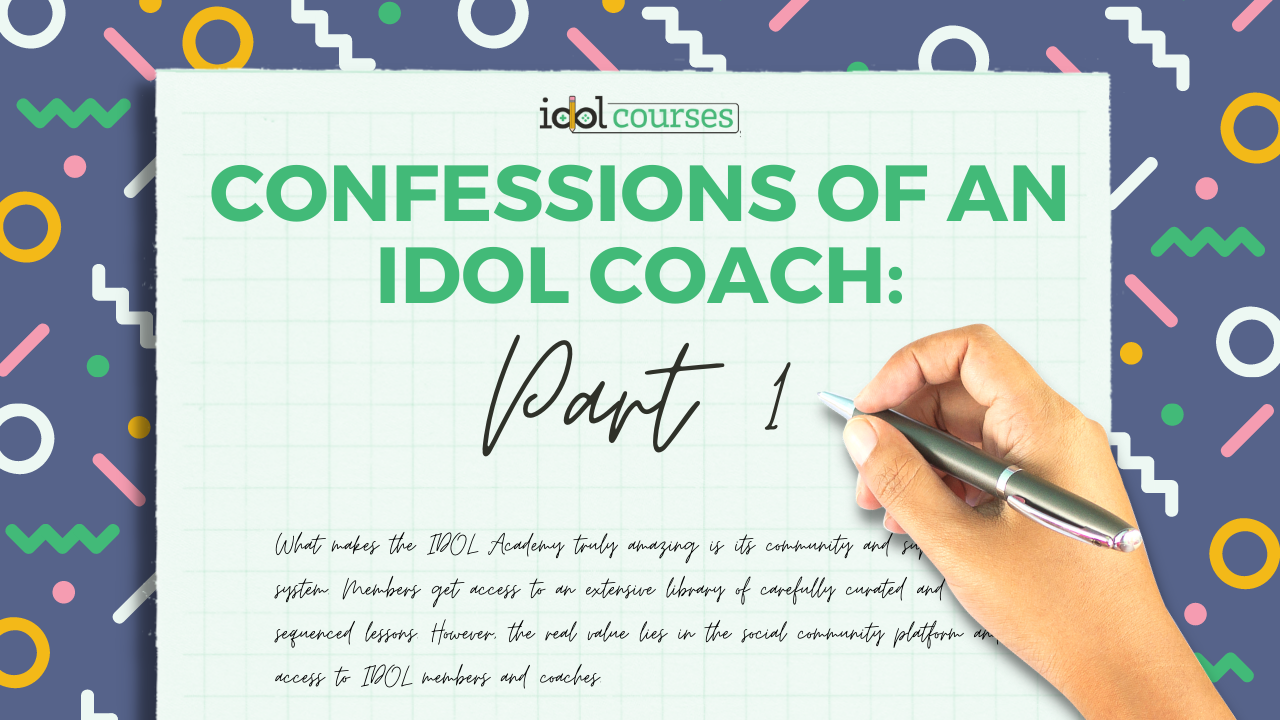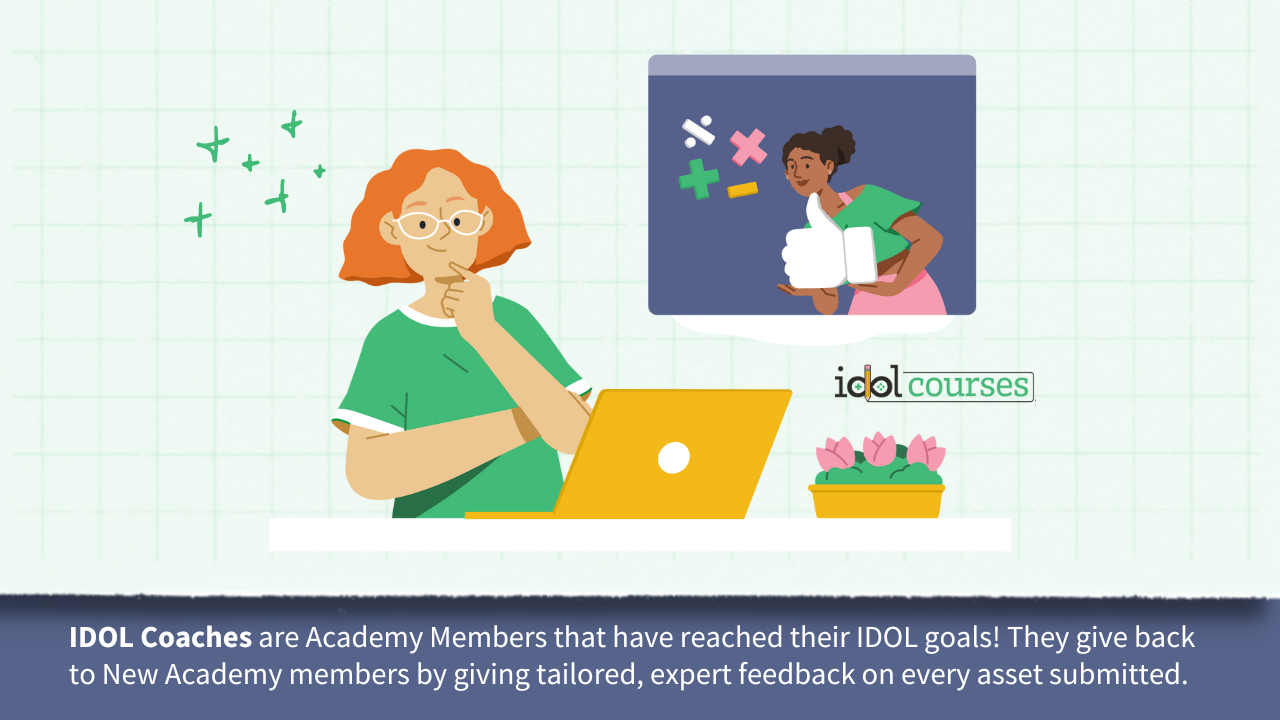Confessions of an IDOL Coach: Part 1
Aug 18, 2023
What makes IDOL Academy truly amazing is its community and support system. It’s not just a collection of ID-related lessons, but it provides mentoring and coaching as well. In this insightful post, IDOL coach Ivett Csordas shares how coaching works and what her method is for giving feedback.

What makes the IDOL Academy truly amazing is its community and support system. Members get access to an extensive library of carefully curated and sequenced lessons. However, the real value lies in the social community platform and access to IDOL members and coaches.
The difference between IDOL mentors and IDOL coaches is that mentors work with the members. They run weekly virtual catch-ups with their small group of mentees. They basically work with them and truly mentor them to become better learning content designers.
On the other hand, coaches are not truly coaches in the real meaning of the word. In IDOL Academy, coaches stay in the background and they provide members feedback on their projects whenever they’re asked to.
I’ve been an IDOL coach for over a year and a half and I absolutely love it. Let me share how it works and why it’s awesome.
How coaching works
We, coaches, are basically on standby, ready to review any projects IDOL members submit to us.
Members can submit anything to us. I most commonly review portfolios, Rise courses, and job aids, but we also get a lot of training blueprints, scripts, videos, resumes etc.
While we look at anything, we only request that members have those projects reviewed by others in the community beforehand. They can get peer feedback via the social community platform, their accountability group, or their mentoring group before us.
Once they’re ready to submit something to us, they fill in a brief form via the academy where they explain the context, and the learning objective, and ask specific questions. They then can choose which of the coaches they want to review their project. We’re all different, so when members choose, they usually select us based on our expertise but we also indicate how we give feedback. I, for example, describe my coaching style as candid with a little tough love but plenty of solutions, but there are other coaches and coaching styles to choose from.
Once members fill in the form, the requested coach provides feedback within 3-4 working days.
How coaches provide feedback
All the coaching requests appear on our project board so that no request gets overlooked. I usually check the board twice a week to make sure that my feedback is within 3 working days.
Some coaches provide annotations or write detailed emails, but many of us do a video review. If I get a project with commenting enabled, the first thing I do is leave comments, but even then I record a video giving feedback. I prefer videos not only because it’s easier to record one than type up feedback, but also because it captures my reactions and allows me to highlight very specific things in the project.
Now, one thing I haven’t mentioned yet is that we do get paid for coaching. That means that when I give feedback, I do a thorough job. It’s not a quick glance, it’s not a “2 compliments, 1 suggestion” kind of feedback, it’s detailed. If it’s a straightforward image or a shell of a website, I may only spend 10 minutes on it, but more often than not, just the video recordings are around 15-20 minutes long, and that doesn’t include the time spent reading or going through the actual content.
When we give feedback, we answer the questions the members ask us in the form and we focus on the areas they tell us that they struggled with. In addition, I always give general feedback as well. I also say that regardless of what they say in the form, my priorities are making sure that the learning experience aligns with the overall learning goal and that the users have a frictionless, frustration-free experience.
How coaching helps
Coaching is essentially receiving feedback and people learn the best from their own projects and mistakes. I’d love to say that there are not many mistakes in the projects that we review, but that’s not true. We see a lot of issues and the same issues repeated over again. But that’s fine. The point is to make these mistakes in the safety of the academy and correct them before they become bad habits.
Coaching is a dedicated, personalized and professional set of eyes to spot things new instructional designers may not be aware of. At one point, for example, I provided more feedback than the person had asked for and I probably mentioned it in the recording, because I got an email response thanking me for including those details. They said that they didn’t know what they didn’t know so they couldn’t have articulated those questions to me before receiving my feedback.
Another good thing about coaching in the academy is that members get to choose from different coaches. There are many of us and people don’t need to stick with one coach. They can try different coaches to see whose style works best for them, or they can even submit the same asset to different coaches to get different perspectives. Although I’d say this last one hardly happens and many times people stick with a coach, especially while they’re implementing the feedback.
It can also happen that we find a deeper issue with the project so we have to work with the member through many rounds of feedback to improve it. For example, once I had somebody submit a project that just felt so odd. After the second round of review, we decided it was best to take a step back and review the project blueprint and there it was: the plan was all wrong. So then we had to define the learning objective again and devise a new outline for the course.
One of my all-time favourite coaching experiences was actually with someone I’d been harsh with. There were several things wrong with the project and I sent them my review first and then, after regretting my brutal honesty, I also sent a kind of apology email. Their response was just gratitude. They said that all they cared about was getting better and they needed to hear my observations to do that. They also said that they’d learned more from my feedback than anything else up to then.
Why I do coaching
I think by now it’s clear that I love being an IDOL Coach. I love giving back to the community and helping people get better. As a former teacher now working in instructional design, that personal interaction and the feeling that I’m making a palpable impact is something I don’t need to miss thanks to coaching at IDOL. Yes, I do get paid and when I have a lot of feedback requests come in at once, it can feel like a real job, but don’t forget that I also learn a lot through the different projects I see.

Written by: Ivett Csordas
Ivett is a teacher turned Learning Content Manager / Instructional Designer. She’s also an IDOL Coach and the founder of the Learning Content Accessibility Spotlight newsletter and group. She is passionate about sharing knowledge and creating meaningful and inclusive learning experiences. Her niche is breaking concepts down and anticipating potential learning obstacles. She also loves watching plays in the theatre and going on backpacking adventures. Connect with her on LinkedIn or check out her portfolio.
Stay connected with news and updates!
Join our mailing list to receive the latest news and updates from our team.
Don't worry, your information will not be shared.
We hate SPAM. We will never sell your information, for any reason.


